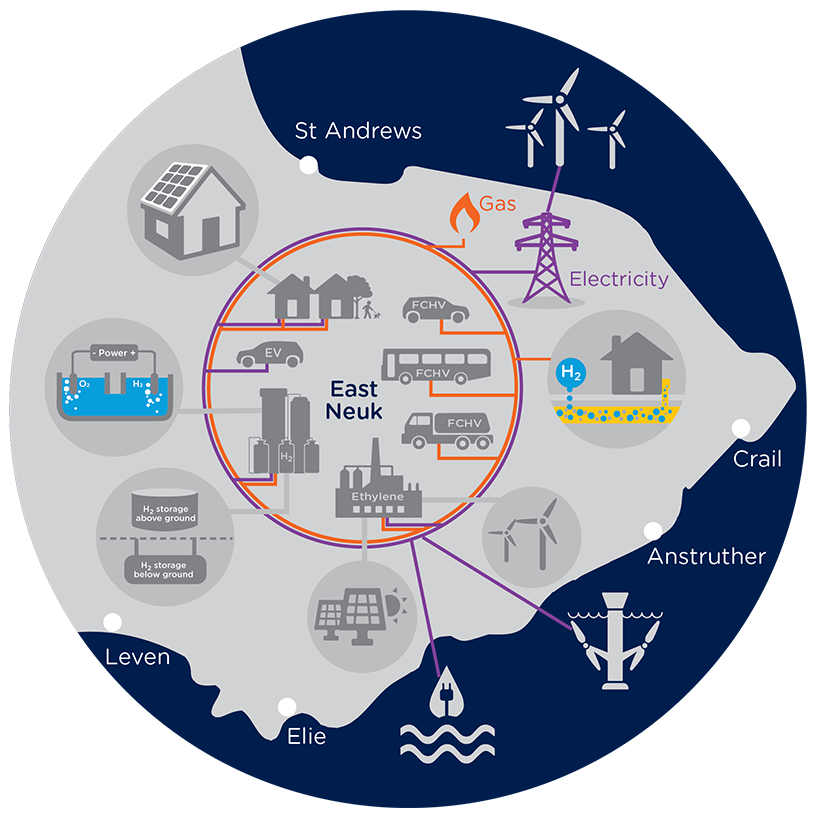Developing the capability to produce hydrogen at scale is one of the key challenges in the race to meet the UK’s ambitious net zero targets.
Using the East Neuk of Fife - with its abundant on- and offshore renewables resource and well-developed electricity and gas networks – as a test bed, we investigated the use of surplus electricity generated by renewables to produce green hydrogen, which could then be used to heat homes and businesses carbon-free.

With its abundant renewables resource and well-developed electricity and gas networks, the East Neuk of Fife is the ideal test bed for studying how green hydrogen can be produced cleanly.
Aims
The study focused on answering a number of important questions around bringing power-to-hydrogen to Fife, including:
- How much low-cost, low-carbon electricity would be available to a power-to-hydrogen operator in Fife, and how much hydrogen could be produced today and in 2040?
- How much hydrogen storage would be required to meet demand under three end-use cases: injection into the natural gas grid; use in a dedicated hydrogen grid for heating; and use as transport fuel for a small fleet of vehicles?
- What, if any, network upgrades could be avoided by implementing power-to-hydrogen?
- Which hydrogen end-use markets would be most attractive for a power-to-hydrogen operator?
- What are the regulatory, legislative, or market barriers to be overcome to realise large-scale deployment of power-to-hydrogen?
The study
Our expert researchers used a high-level model of the European electricity system and established wholesale prices, generation volumes by generation type, and constrained generation in Fife. Considering both the present day and a 2040 picture based on National Grid’s Two Degrees Future Energy Scenarios, our team explored a number of configurations of power generation and hydrogen end-use to assess the value associated with producing hydrogen.
Alongside this modelling, our team conducted a comprehensive review of power-to-hydrogen legislation and regulation, and reports and academic papers to identify the current characteristics and direction of the sector, observe where most progress had been made, and identify lessons learned.
Findings
The study found that cheap, low-carbon power could underpin cost-effective hydrogen production in Fife. The area’s energy attributes could make it a centre for hydrogen production, with high levels of grid connectivity. It also opens the door for hydrogen production in other renewable energy centres.
While locally-constrained generation alone is unlikely to deliver enough low-cost hydrogen to fuel meaningful amounts of heat or transport in the region, there could be other regions where curtailed electricity could offer a more compelling case, especially as renewables deployment increases.
The study also found that using renewable energy dedicated to hydrogen production can drive deployment and lessen the need for costly network upgrades. Analysis found that large-scale offshore renewables deployment off the coast of Fife may be restricted by its inability to connect directly into the area’s electricity network. The offshore production of hydrogen could be a cheaper alternative to onshore production.
Low-cost electricity is key to successful power-to-hydrogen business cases. The cost of using dedicated renewable power for electrolysis is significantly more attractive than commercial or industrial electricity price.
Access to storage will be crucial for the viability of a pure hydrogen grid. Being able to capture excess renewables generation or low-cost electricity for later use will be a critical factor in reducing the cost of hydrogen and maximising security of supply.
Transport fuel is likely to be the most attractive market for a power-to-hydrogen operator in the short term.
The current legislation around power-to-hydrogen remains unclear, which could limit market development. Uncertainty remains for companies wishing to enter the market, which could delay the development of a vibrant, competitive environment.
Conclusion
With several promising pilot projects underway across the UK, hydrogen has shown early promise as a zero-carbon solution for heating and transport. However, its wider rollout will depend on whether the gas can be generated cost-effectively on an industrial scale.
Our East Neuk Power to Hydrogen project answered a number of the key questions on a regional scale, examining the possibility of producing hydrogen using constrained renewable energy in Fife, and pinpointed other areas of the UK – and further areas of study – for hydrogen’s wider-scale development: making it a locally-focused project that could have a national impact.

